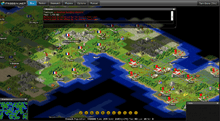Browser game
A browser game is a computer game that is played over the Internet using a web browser.[1] Browser games can be run using standard web technologies[2] or browser plug-ins. The creation of such games usually involves use of standard web technologies as a frontend and other technologies to provide a backend. Browser games include all video game genres and can be single-player or multiplayer. Browser games are also portable and can be played on multiple different devices, web browsers, and operating systems. [3]
Browser games come in many genres and themes that appeal to both regular and casual players.
Characteristics
Browser games are often free-to-play and do not require any client software to be installed apart from a web browser or browser plug-in. In some cases a game may be free, but charge for extra in-game features. Multiplayer browser games have an additional focus on social interaction, either between several players or on a massive scale. Due to the accessibility of browser games, they are often played in more frequent, shorter sessions compared to traditional computer games.[4]
Since browser games run isolated from hardware in a web browser, they can run on many different operating systems without having to be ported to each platform.[5]
Persistence
A persistent browser-based game is a video game that is both browser-based and persistent.
Persistent browser-based games usually rely on some kind of server-side code; though some will use technologies like Flash, ActiveX, and Java applets to store data on the client's computer. Games relying on client-side technology are rarer due to the security aspects that must be dealt with when reading and writing from a user's local file system - the web browser doesn't want web pages to be able to destroy the user's computer, and the game designer doesn't want the game files stored in an easily accessed place where the user can edit them. The server-side code will store persistent information about players and possibly the game world in some kind of database.
Sustainability, especially when combined with persistence is a key distinction of a PBBG. This allows dynamic system modelling elements to develop and progress (stuff happens), even while the player is offline. Such games often last for several months.
Technologies
Browser games can take advantage of different technologies in order to function.
Web standards
Standard web technologies such as HTML, CSS, PHP, and JavaScript can be used to make browser games, but these have had limited success because of issues with browser compatibility and quality. These technologies allow for games that can be run in all standards-compliant browsers.[6] In addition, dedicated graphics technologies such as SVG and canvas allow for the fast rendering of vector and raster graphics respectively.[2] In addition, WebGL allows for hardware-accelerated 3D support in the browser.[7][8]
| Chrome | Firefox | Internet Explorer | Opera | Safari | |
|---|---|---|---|---|---|
| SVG | Yes | Yes | Yes | Yes | Yes |
| Canvas | Yes | Yes | Yes | Yes | Yes |
| WebGL | Yes | Yes[9] | Yes [10] | Yes | Yes |
Plug-in
Browser plug-ins can be used to provide game technologies after being installed by the user.
| Windows | Mac OS X | Linux | License[notes 2] | Installed base[notes 3] | |
|---|---|---|---|---|---|
| Flash | Yes | Yes | Yes | Proprietary[11] | 96%[12] |
| Java | Yes | Yes | Yes | Open source (free)[13][14] | 78%[12] |
| Shockwave | Yes | Yes | No | Proprietary[15] | 52%[16] |
| Silverlight | Yes | Yes | Partial (Moonlight - LGPL) | Proprietary[17] | 62%[12] |
| Unity | Yes | Yes | No | Proprietary[18] | 1%[19] |
See also
Notes
References
- ↑ D Schultheiss: Long-term motivations to play MMOGs: A longitudinal study on motivations, experience and behavior, page 344. DiGRA, 2007.
- 1 2 "Graphics — W3C". W3.org. 2010-02-18. Retrieved 2010-05-20.
- ↑ "The PBBG Project". Pbbg.org. Retrieved 2010-05-20.
- ↑ C Klimmt: Exploring the Enjoyment of Playing Browser Games, page 231. CyberPsychology & Behavior, 2009.
- ↑ E Adams: Fundamentals of Game Design, page 80. New Riders, 2009.
- ↑ Downes, Stephen (August 17, 1999). "Fun and Games With DHTML". Stephen's Web. Downes.ca. Retrieved 2010-05-20.
- ↑ Anthony, Sebastian (2009-12-11). "3D browser apps and games creep ever closer with the WebGL draft standard". Downloadsquad.com. Retrieved 2010-05-20.
- ↑ Ramsdale, Chris (April 1, 2010). "Look ma, no plugin!". Google Web Toolkit Blog. Google. Retrieved 2010-05-20 – via Blogspot.
- ↑ "Mozilla Firefox 4 Release Notes". Mozilla.com. 2011-03-22. Retrieved 2013-06-29.
- ↑ "WebGL (Preliminary)". MSDN. Microsoft. 25 July 2013. Retrieved 26 July 2013.
- ↑ "Flash EULA" (PDF). Retrieved 2011-03-10.
- 1 2 3 "Web Browser Plugin Market Share / Global Usage". Statowl.com. Retrieved 2010-04-08.
- ↑ "Moving to OpenJDK as the official Java SE 7 Reference Implementation (Henrik on Java)". oracle.com.
- ↑ "Java Platform, Standard Edition 7 Reference Implementations — Project Kenai". java.net.
- ↑ "Shockwave EULA" (PDF). Retrieved 2011-03-10.
- ↑ "Shockwave Player Adoption Statistics". Adobe. Retrieved 2010-04-08.
- ↑ "Terms Of Use". Retrieved 2011-03-10.
- ↑ "END USER LICENSE AGREEMENT". Retrieved 2011-03-10.
- ↑ "Thoughts On Browser Plugin Penetration". Unity Technologies. Retrieved 2011-03-10.
